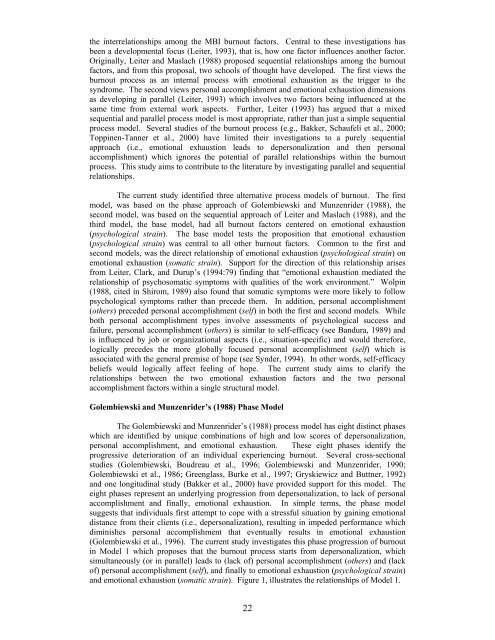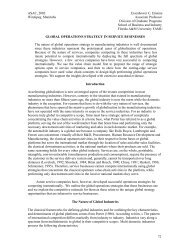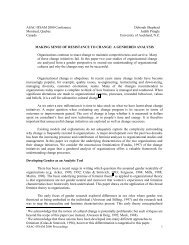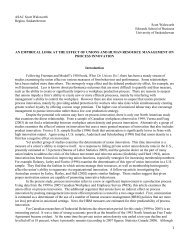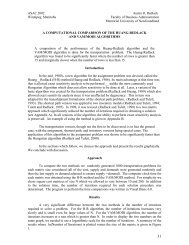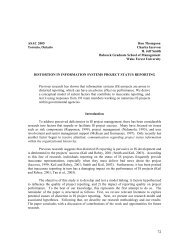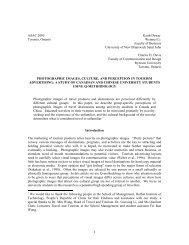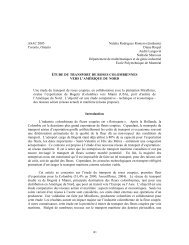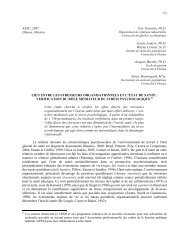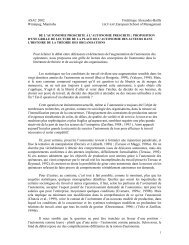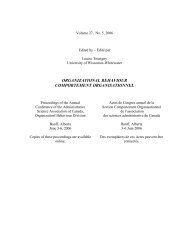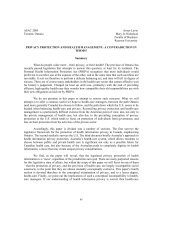the interrelationships among the MBI burnout factors. Central to these investigations hasbeen a developmental focus (Leiter, 1993), that is, how one factor influences another factor.Originally, Leiter and Maslach (1988) proposed sequential relationships among the burnoutfactors, and from this proposal, two schools of thought have developed. The first views theburnout process as an internal process with emotional exhaustion as the trigger to thesyndrome. The second views personal accomplishment and emotional exhaustion dimensionsas developing in parallel (Leiter, 1993) which involves two factors being influenced at thesame time from external work aspects. Further, Leiter (1993) has argued that a mixedsequential and parallel process model is most appropriate, rather than just a simple sequentialprocess model. Several studies of the burnout process (e.g., Bakker, Schaufeli et al., 2000;Toppinen-Tanner et al., 2000) have limited their investigations to a purely sequentialapproach (i.e., emotional exhaustion leads to depersonalization and then personalaccomplishment) which ignores the potential of parallel relationships within the burnoutprocess. This study aims to contribute to the literature by investigating parallel and sequentialrelationships.The current study identified three alternative process models of burnout. The firstmodel, was based on the phase approach of Golembiewski and Munzenrider (1988), thesecond model, was based on the sequential approach of Leiter and Maslach (1988), and thethird model, the base model, had all burnout factors centered on emotional exhaustion(psychological strain). The base model tests the proposition that emotional exhaustion(psychological strain) was central to all other burnout factors. Common to the first andsecond models, was the direct relationship of emotional exhaustion (psychological strain) onemotional exhaustion (somatic strain). Support for the direction of this relationship arisesfrom Leiter, Clark, and Durup’s (1994:79) finding that “emotional exhaustion mediated therelationship of psychosomatic symptoms with qualities of the work environment.” Wolpin(1988, cited in Shirom, 1989) also found that somatic symptoms were more likely to followpsychological symptoms rather than precede them. In addition, personal accomplishment(others) preceded personal accomplishment (self) in both the first and second models. Whileboth personal accomplishment types involve assessments of psychological success andfailure, personal accomplishment (others) is similar to self-efficacy (see Bandura, 1989) andis influenced by job or organizational aspects (i.e., situation-specific) and would therefore,logically precedes the more globally focused personal accomplishment (self) which isassociated with the general premise of hope (see Synder, 1994). In other words, self-efficacybeliefs would logically affect feeling of hope. The current study aims to clarify therelationships between the two emotional exhaustion factors and the two personalaccomplishment factors within a single structural model.Golembiewski and Munzenrider’s (1988) Phase ModelThe Golembiewski and Munzenrider’s (1988) process model has eight distinct phaseswhich are identified by unique combinations of high and low scores of depersonalization,personal accomplishment, and emotional exhaustion. These eight phases identify theprogressive deterioration of an individual experiencing burnout. Several cross-sectionalstudies (Golembiewski, Boudreau et al., 1996; Golembiewski and Munzenrider, 1990;Golembiewski et al., 1986; Greenglass, Burke et al., 1997; Gryskiewicz and Buttner, 1992)and one longitudinal study (Bakker et al., 2000) have provided support for this model. Theeight phases represent an underlying progression from depersonalization, to lack of personalaccomplishment and finally, emotional exhaustion. In simple terms, the phase modelsuggests that individuals first attempt to cope with a stressful situation by gaining emotionaldistance from their clients (i.e., depersonalization), resulting in impeded performance whichdiminishes personal accomplishment that eventually results in emotional exhaustion(Golembiewski et al., 1996). The current study investigates this phase progression of burnoutin Model 1 which proposes that the burnout process starts from depersonalization, whichsimultaneously (or in parallel) leads to (lack of) personal accomplishment (others) and (lackof) personal accomplishment (self), and finally to emotional exhaustion (psychological strain)and emotional exhaustion (somatic strain). Figure 1, illustrates the relationships of Model 1.22
Insert Figure 1 hereLeiter and Maslach’s (1988) Sequential ModelLeiter and Maslach (1988) proposed an alternative burnout process model toGolembiewski and Munzenrider’s (1988) Phase Model. Their sequential model placesemotional exhaustion as central or the starting point of the phenomenon, where emotionalexhaustion first influences depersonalization and in turn, depersonalization then influencespersonal accomplishment. Several cross-sectional studies (Greenglass et al., 1997; Lee andAshforth, 1993; Leiter and Schaufeli, 1996) and one longitudinal study (Bakker et al., 2000)have supported the sequential model approach. In simple terms, the sequential modelsuggests that in stressful situations where individuals become over stimulated and exhausted(i.e., emotional exhaustion), they cope by depersonalizing their clients which leads todiminished personal accomplishment. Consequently, the resulting order of burnout factors,and subsequent interpretation of the burnout process is substantially different from the phasemodel proposed by Golembiewski and Munzenrider (1988).Leiter (1993) suggested an additional improvement to the sequential model byasserting that emotional exhaustion and personal accomplishment develop separately or inparallel. He argued that the working environment affects each of these factors differently andtherefore each factor reacts independently. Further, both emotional exhaustion and personalaccomplishment (self) are similar to what Burisch (1993: 91) terms “second-order stress”which results from failed attempts to remedy situations. In the current study, Model 2presents the burnout progression identified by the sequential model, along with Leiter’ssuggested improvements. In Model 2, the burnout process starts from emotional exhaustion(psychological strain) which is central to all other burnout factors, except personalaccomplishment (self). Emotional exhaustion (psychological strain) represents the reaction ofindividuals to the accumulating effect of long-term stressors, or in other words, overstimulation and exhaustion. Emotional exhaustion (psychological strain) then simultaneouslyinfluences three of the four burnout factors, namely emotional exhaustion (somatic strain),depersonalization, and personal accomplishment (others). Personal accomplishment (self) isthe last remaining factor and influenced by personal accomplishment (others). Figure 2,illustrates the relationships of Model 2.Insert Figure 2 hereIn summary, the current study aims to address the deficiency in understanding theburnout process, by (a) increasing our comprehension of burnout in senior managerialpositions, (b) clarifying the burnout process among senior law enforcement officers, (c)incorporating and investigating parallel and sequential relationships of the burnout process,and (d) clarifying the relationships between the two emotional exhaustion factors and the twopersonal accomplishment factors within a single structural model.MethodQuestionnaires mailed out to 585 law enforcement senior officers and 480 were returnedwhich achieves a response rate of 82%. A randomly stratified sample design achievedproportional representation. The chi-square value and associated level of significance (χ 2 =6.56; d.f. = 4; p> .05) indicates that the achieved sample was not significantly different fromthe population.MeasuresThe MBI (Maslach and Jackson, 1981) consists of 22 items to measure burnout anduses an intensity Likert scale that ranges of 0 (‘Never’) to 7 (‘ Major, very strong’). Several23
- Page 1 and 2: Volume 24, No. 5, 2003Edited by/Éd
- Page 4 and 5: Pursey HeugensGreg IrvingRoderick I
- Page 6 and 7: TABLE OF CONTENTS - TABLE DES MATI
- Page 8 and 9: study of power displays in mixed-ge
- Page 10 and 11: on expectations and behaviour (Berg
- Page 12 and 13: TaskThis study required the use of
- Page 14 and 15: Task-Gender (male-stereotyped or fe
- Page 16 and 17: It is important to understand the s
- Page 18 and 19: Crown, C.L. & Cummins, D.A. (1998).
- Page 20 and 21: Smith-Lovin, L., & Brody, C. (1989)
- Page 22 and 23: Table 2Summary of Descriptive Stati
- Page 24 and 25: Table 4Summary of Interaction of Ge
- Page 26 and 27: ASAC 2003Halifax, Nova ScotiaIain L
- Page 30 and 31: studies (Friedman and Sarros, 1989;
- Page 32 and 33: This study demonstrated that emotio
- Page 34 and 35: Anxiety, Stress and Coping, in pres
- Page 36 and 37: Washington, DC: Taylor and Francis,
- Page 38 and 39: Table 2Overall Goodness-of-Fit Indi
- Page 40 and 41: ζ 3Depersonalizationη 3β 3,1 (+)
- Page 42 and 43: ASAC 2003Halifax, Nova ScotiaWendy
- Page 44 and 45: views independently, gave rise to S
- Page 46 and 47: track assistant, associate, and ful
- Page 48 and 49: ole conflict are positively related
- Page 50 and 51: Table 3. Regression of climate and
- Page 52 and 53: interests.We speculate the null eff
- Page 54 and 55: DOOP and short for DOOP scales,”
- Page 56 and 57: Pelled, L. H., “Demographic diver
- Page 58 and 59: esulting increase in discretion ove
- Page 60 and 61: al., 1995). However, the distinctio
- Page 62 and 63: ise to strong pressures for conform
- Page 64 and 65: presented with a complete list of a
- Page 66 and 67: Table 3QAP Regression Coefficients
- Page 68 and 69: ConclusionResearchers of social inf
- Page 70 and 71: suggestions for further research.
- Page 72 and 73: performing on the job.” Presumabl
- Page 74 and 75: positively related to performance i
- Page 76 and 77: proposed hypotheses were supported.
- Page 78 and 79:
ConclusionThis research has made se
- Page 80 and 81:
Be more enthusiastic and exert extr
- Page 82 and 83:
Table 2Correlations Among the Laten
- Page 84 and 85:
performance expectations on feedbac
- Page 86 and 87:
changements qui s’opèrent dans l
- Page 88 and 89:
structures, politiques, systèmes,
- Page 90 and 91:
comportements liés à la communica
- Page 92 and 93:
Tableau 2Échelles de mesure de la
- Page 94 and 95:
prédiction des compétences clés
- Page 96 and 97:
organisation n’est pas uniforme e
- Page 98 and 99:
complètement ce construit. Ces cha
- Page 100 and 101:
Wagner, R.K. and Sternberg, R.J. (1
- Page 102 and 103:
What is a toxin handler?In two arti
- Page 104 and 105:
potentially limited scope and conte
- Page 106 and 107:
work role demands. In this survey,
- Page 108 and 109:
The three factors in this rotated f
- Page 110 and 111:
and service orientation, the abilit
- Page 112 and 113:
ASAC 2003Halifax, Nova ScotiaLisa M
- Page 114 and 115:
self-appraisal group reacted more n
- Page 116 and 117:
effect of voice are the value-expre
- Page 118 and 119:
“Strongly Disagree” to “Stron
- Page 120 and 121:
esults suggest that incorporating s
- Page 122 and 123:
Personality and Social Psychology,
- Page 124 and 125:
Table 1Means, Standard Deviations,
- Page 126 and 127:
Table 3Test of the Mediating Role o
- Page 128 and 129:
ASAC 2003Halifax, Nova ScotiaAnn Fr
- Page 130 and 131:
individual level, polychronicity is
- Page 132 and 133:
construct.Drawing on computer-media
- Page 134 and 135:
Consequence: Impact on Work Overloa
- Page 136 and 137:
Conversation complexity may also mo
- Page 138:
Implications for practiceFuture res
- Page 141 and 142:
ReferencesAncona, D.G., Goodman, P.
- Page 143 and 144:
no. 3 (1994): 381-391.Macan, T.H.,
- Page 145 and 146:
ASAC 2003Halifax, Nova ScotiaIan R.
- Page 147 and 148:
Assessing Measures: Affective Commi
- Page 149 and 150:
implications of psychological contr
- Page 151 and 152:
commitment, affective commitment, c
- Page 153 and 154:
Motivational Process Variables. Amo
- Page 155 and 156:
DiscussionThe main purpose of this
- Page 157 and 158:
approaches zero. In the present stu
- Page 159 and 160:
Extension and test of a three-compo
- Page 162 and 163:
Table 1Descriptive Statistics and Z
- Page 164 and 165:
Table 3Standardized Factor Loadings
- Page 166 and 167:
Table 5Hierarchical Regression Anal
- Page 168 and 169:
ASAC 2003Halifax, Nova ScotiaJoan F
- Page 170 and 171:
ASAC 2003Halifax, Nova ScotiaArla D
- Page 172 and 173:
ASAC 2003Halifax, Nova ScotiaIvy Ky
- Page 174:
ASAC 2003Halifax, Nova ScotiaNina D


